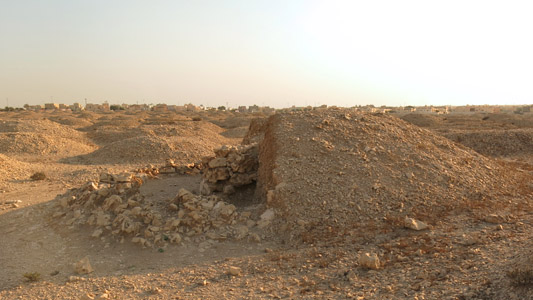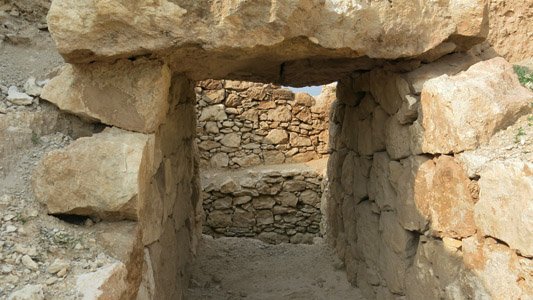Contact Center
.
Typology of Dilmun Burial Mounds
The rich history of the Early Dilmun period is best reflected in the burial practices and construction typology of the Late Type Dilmun Burial Mounds. The tumuli illustrate the sepulchral traditions over a period of three centuries.
A distinction between Early and Late Type burial mounds was first made by Cornwall who conducted excavations in the 1940s. He describes the Early Type mounds as “small and compact rock tumuli” and the Late Type as “larger [...] and gravel covered” mounds (Cornwall 1946, p. 10).
Early Type Burial Mounds

One of the characteristics of the Early Type mounds is that they have an average diameter of about 2.50 metres. The height of the mounds does not normally exceed 1.50 metres, though mounds of larger size appear occasionally (Laursen 2008, p. 157). Cornwall (1946, p. 10) notes that the mounds usually conceal a crude cist, but some seem to have a core built with randomly piled stones. The layout of the burial chambers differs as the chamber of the smaller mounds is normally oval, while larger mounds show a distinctive L-, T-, H-shape, or, in some cases, an even more complex shape (Laursen 2008, pp. 157-158).
According to Laursen (2008, pp. 158-159), so far almost 1000 Early Type burial mounds have been excavated in the course of time.
The recovered pottery, among them Umm an-Nar pieces and Mesopotamian vessels, as well as the absence of seals, suggest an approximate date of 2200 to 2050 BCE.
The Early Type mounds are primarily situated on the slopes of the limestone formation in central Bahrain where they cover a broad crescent-shaped area around Riffa. They normally appear scattered rather than clustered and their distribution is largely dictated by the splintered topography of the wadi banks. There is also a geographical connection to the Late Type mounds. As noted by Laursen (2008, p. 158), Early Type mounds are found closer to the central basin of the island, usually at a higher point than the Late Type mounds.
Approximately 17,000 Early Type mounds were recorded by the Danish-Bahraini mapping project (Laursen 2008, p. 159) of which about 1,000 remain until today.
Late Type Burial Mounds

The Late Type mounds are larger and appear in high density. A distinctive feature is the immense layer of soil that covers the grave Chambers.
The average burial mounds are about 2 to 3 metres in height and 6 to 11 metres in diameter (Laursen 2008, p. 159). However, there are smaller as well as formidable larger exceptions. The larger Late Type mounds were assigned an extra category taking into account their distinctive architectural characteristics (see Chieftain and Royal Mounds).
The Late Type tumuli consist of regularly built grave chambers with walls built using dry-stone technique and covered by capstone slaps (Højlund 2007, p. 29). The shape of the chamber varies as they appear in L-, T-, H- or even more complex shapes (Laursen 2008, p. 159).
Despite the different shapes within the ring wall, there is only one chamber with several alcoves which opens in south-western direction.
The excavated grave furniture allows for the Late Type burial mounds to be dated to a period between 2050 and 1750 BCE. The age determination is mainly based on comparisons with material from the Dilmunite capital Qal’at al-Bahrain, the island of Failaka, and Barbar Temples (Laursen 2008, p. 159).
The tumuli are placed in close proximity to each other forming dense cemeteries which are mostly located along the western side of Bahrain´s limestone dome (Laursen 2008, p. 159). Rice (1994, pp. 198-199) speculates that the Late Type tumuli cemeteries have been built on an industrial basis considering that the tumuli are laid out in “funerary estates” rather than in scattered zones.
A mapping project organised by the Danish-Bahraini team of archaeologists suggested a number of 58,000 Late Type mounds (Laursen 2008, p. 159), of which about 13,500 still remain.
Chieftain and Royal Mounds

Chieftain and royal mounds emerged between 2050 and 1750 BCE. They are therefore contemporaneous to the Late Type burials mounds.
Compared to the latter, chieftain and royal mounds are much larger in size (Højlund 2007, p. 26).
They usually consist of two-storeyed burial chambers as well as four or six alcoves with plastered walls. In contrast to the Late Type mounds, the chieftain and royal mounds are accessible either through a shaft or a passage (Højlund 2007, p. 29). In addition to the lower ring wall, they display a second, upper ring wall that can indicate the previous existence of a second storey. However, there are also examples of single-storeyed mounds with an upper ring wall that were mainly aimed at protecting the access shaft.
Though both chieftain and royal mounds present the same architectural characteristics, they can be differentiated in size.
While chieftain mounds reach diameters of 13 to 26 metres, royal mounds display diameters of up to 50 metres and heights up to 12 metres (Højlund 2007, p. 145). The variations in sizes and complexity between the mounds, which occur during the second half of the Early Dilmun period, suggest a more diversified and hierarchic society. Consequently, the group of larger mounds is referred to as chieftain mounds, and the group of the very large mounds is called royal mounds. Although this terminology is applied, no research has distinctively proven the existence of a monarchic dynasty in relation to the mounds. They could also be “family mausolea, or the restingplaces of people linked by clan ties” (Rice 1994, p. 178).
In 1954, Globe excavated one of the chieftain mounds in Janabiyah. Based on his findings, archaeological evidence suggests that the chambers were not immediately closed after being built but rather left open and covered only after the burial (Højlund 2007, p. 47).
Burial Mounds with Subsidiary Burials

This is a special type of tumuli which occurs throughout the Early Dilmun period. These burial mounds are characterized by a central burial with one or more subsidiary burials connected to it. They can be found in all of the burial mound cemeteries in Bahrain. Some excellent examples are featured in Janabiyah and Madinat Hamad 2 Burial Mound Fields (Laursen 2013, p. 127).
The special feature of the mounds is only revealed through excavation.
Only in rare cases, when there is a high number of attached burials, can the shape of the mound provide some hints. According to Ibrahim (1982, p. 12) the mounds were not expanded out of sudden necessity but rather intentionally constructed this way. He argues that the mounds are located in an area big enough to provide for the entire burial complex.
The construction technique of the central burial can be similar to Early Type, Late Type, or chieftain mounds. If the burial chamber is L- or T-shaped, it is surrounded by a ring wall, which is built higher in places where there are subsidiary burials. In the case where the central area is a chieftain burial, the chamber is accessible via an entrance shaft (Ibrahim 1982, p. 18). The additional burial chambers are surrounded by semi-ring walls that are either attached to the central burial or to another semi-ring wall. The burial chambers are rather simple and normally do not possess alcoves (Ibrahim 1982, pp. 12-13; Lowe 1986, p. 73).
The reason for the construction of such burial clusters is uncertain.
It can, however, be assumed that the buried individuals are in some kind of relation, most likely family. The distinct sizes of the burials indicate that some of them belong to children (Ibrahim 1982, p. 12).







